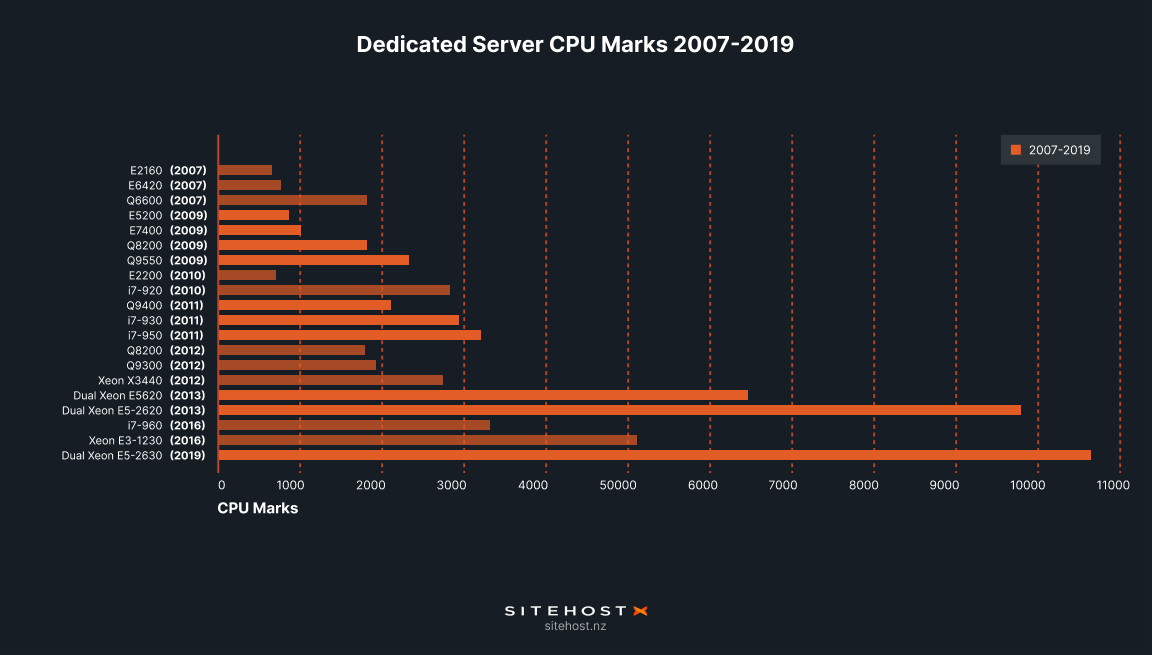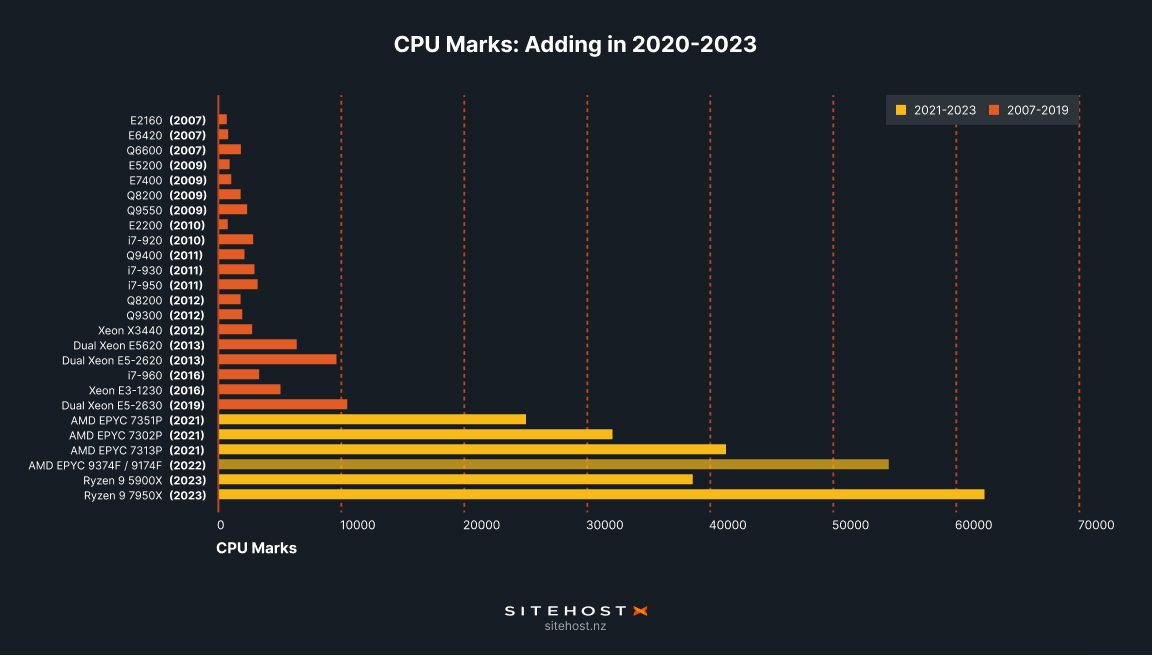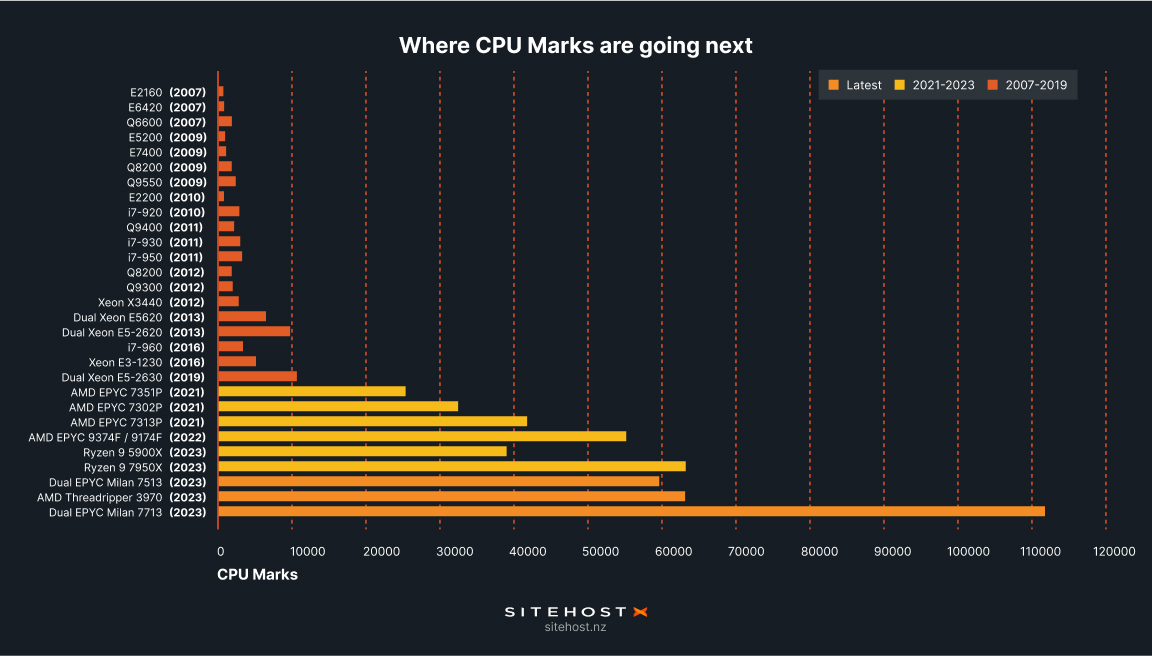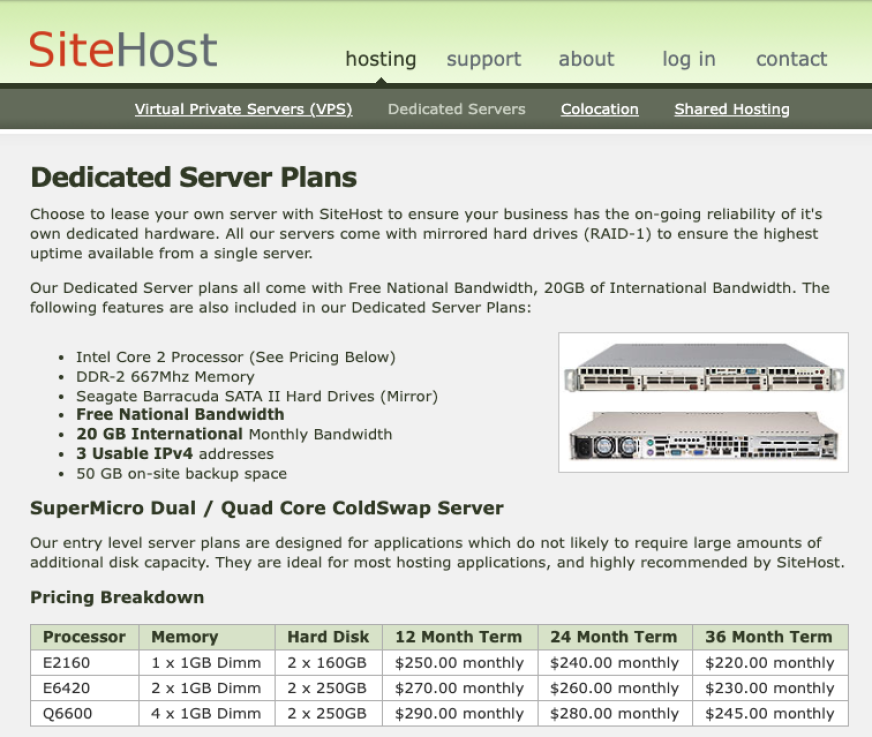The launch of our new Dedicated Servers got us thinking about how hardware evolves. Exactly how have Dedicated Servers changed over the 15+ years we've offered them? To find out we've looked back as far as the Wayback Machine can take us, to 2007, listed almost every processor (CPU) that we've offered, and checked its performance on CPUbenchmark.net.
Even for gearheads like us, the results are pretty amazing.
On the money
Before we dig into CPU scores, let’s quickly talk about money. In the 2007 screenshot above our Dedicated Servers cost $220-$290 a month. The Reserve Bank’s inflation calculator says that's $325-$429/mo in today’s dollars.
Things have stayed so consistent that right now our Dedicated Servers still start at $380/mo. There’s been a bit of variation, especially at the top end as we’ve offered higher-performance machines. But while we go through some nearly-inconceivable changes in computing power bear in mind that the dollar figures have stayed remarkably flat.
Related article: Bigger, better, faster - Hard drive history, 2007-2023
2007-2019: The Intel and Xeon years
Now to the main event: CPU performance. These figures come from an external source, CPUbenchmark.net. Its tests look at nine different types of performance like encrypting data and finding prime numbers, and then collates a single score, called the CPU Mark, for each processor. (The numbers we’ve used are for the earliest available version of each processor model.)
The year alongside each model number shows when the processor was first included in one of our Dedicated Server packages. Here's how CPU Marks grew over the first 12 years:

To get the ball rolling our 2007 Dedicated Servers offered three Intel processors. The low end E2160 has a CPU Mark of 641, and the Q6600 topped the original heap with 1,804.
Things steadily improved as Intel rolled out the E and Q series. Then in 2011 we introduced the i7 series and reached the 3,191 with the i7-950. That’s around 5x the E2160 score from 2007.
As a rule of thumb, every time a CPU Mark doubles, the cost of hosting your own software or services halves.
Only two years later, in 2013, Xeon chips (also from Intel) replaced i7s as the stars of the show with CPU Marks as high as 9,730. At the end of 2010s we finally broke the five-figure barrier. The Dual Xeon E5-2630's 10,630 added an order of magnitude to the processors that we started with.
Which seems pretty good, right? Hold on though.
In the 2020s, the game has changed
This decade isn't even halfway done and our graph already needs to zoom a long way out. Everything we've already seen is still in orange, and recent additions are yellow:

Intel spent a few too many years relying on 14 nanometre lithography, which slowed things down in the second half of the 2010s. So we turned to AMD and as soon as their EPYC processors turned up, everything changed again.
EPYC CPUs come in a few different flavours. At first they brought in CPU Marks from 25,431 to 55,485. Today we're up to the 4th generation of this family.
Our most recent refresh of the Dedicated Server line-up introduced Ryzen 9 CPUs (which you'll also find in our High Performance Virtual Servers). The 7950X hits 63,455. With just the smallest bit of rounding, that's a 100-fold increase from 641 where we started. After 17 years the computing power that used to be worth a dollar now costs much closer to a cent.
If this was our final destination, we would have come a long way. But there's still more.
A peek at the future of dedicated hardware
To see the most amazing CPUs that we're offering these days, we need to zoom out one more time:

This is a bit of a gear change - figuratively and literally - so let's explain what's going on. We have added GPU Hosting as a new product line this year. Just like Dedicated Servers, these are machines that you can rent by the month or year, and which you get all to yourself. The big difference is that these machines include Nvidia GPUs as well as CPUs from AMD.
We don't offer these exact CPUs in Dedicated Servers, but they show where the performance statistics are heading next.
The Dual EPYC Milan 7713 has a CPU Mark of 112,464 and almost doubles the record set by Ryzen 9s a couple of paragraphs ago. All of which is a long way to say: We are in a time of rapid, rapid improvement.
Not just abstract numbers
It’s easy to get lost in the scale of these CPU improvements over time, but don't lose sight of what these numbers actually tell us.
CPU Marks are literally a measure of what businesses can achieve on their own machines. As a rough rule of thumb every time a CPU Mark doubles, the cost of hosting your own software or services halves. If your business is running on dedicated hardware, this is unalloyed good news. If it isn't, then these figures might be a reason to revisit that decision.
If you're balancing cloud services against dedicated hardware, the second choice has improved 100 times over since 2007 (and not just in terms of CPU, as we saw in our deep dive into storage and hard drives). When you hear about companies leaving the cloud and returning to the world of bare metal, they’re chasing a return on their investment. The value of a dollar has changed dramatically in server-land. The world of services has not had as much good news. (For a summary of these trends in October 2024, we asked NotebookLM to make quick work of the long Cloud Exit story.)
As well as having a very good idea of what's possible on dedicated hardware, we also have plenty of experience in helping businesses compare their options. Time for some expert advice? Let's talk.
Main image: Photo by Brian Kostiuk on Unsplash


